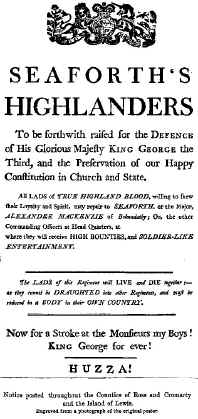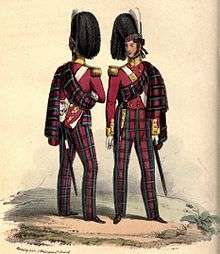72nd Regiment, Duke of Albany's Own Highlanders
| 72nd Highland Regiment | |
|---|---|
 Regimental cap badge | |
| Active | 1778–1881 |
| Country |
|
| Branch |
|
| Type | Infantry Regiment |
| Role | Infantry |
| Size | One battalion (two battalions 1804–1816) |
| Garrison/HQ | Stirling Castle |
| Engagements |
Second Anglo-Mysore War Third Anglo-Mysore War French Revolutionary Wars Napoleonic Wars Crimean War Ambela Campaign Second Anglo-Afghan War |
The 72nd Highlanders was a British Army Highland Infantry Regiment of the Line, raised in 1778. Under the Childers Reforms it amalgamated with the 78th (Highlanders) Regiment to form the 1st Battalion of the Seaforth Highlanders in 1881.
History
Early history


The regiment was raised in the Western Highlands by Kenneth Mackenzie as the Seaforth (Highland) Regiment in January 1778[1] in an act of gratitude for the restoration of the family Earldom which had been forfeited during Jacobite rising of 1715. A corps of 1,130 men was raised of whom 900 were Highlanders and the remainder came from the Lowlands: it was established at Elgin, its first base, in May 1778.[2]

In August 1778 the Regiment marched to Leith for embarkation to the India – but a dispute regarding their terms of service led the men to march back to Edinburgh and they took up a position of protest in the vicinity of Arthur's Seat, remaining for several days. During this protest, the men were amply supplied with food and ammunition by the people of the capital, who had taken side with them in their grievances. After three days of negotiations, compromises were reached and the men again marched from the capital to their quarters at Leith, this time led by the Earl of Seaforth, but the idea of sending them to India now having been abandoned.[Note 1][3] At this time, the regiment was designated the 78th (Highland) Regiment of Foot, or Seaforth (Highland) Regiment.[3] The regiment embarked for Jersey in September 1778 and helped repulse a French invasion of Jersey in May 1779 before returning to England in April 1781.[4]
The regiment embarked from Portsmouth, with a unit strength of 973 rank and file, in June 1781.[5] Because of change of diet, rough seas and scurvy 274 had died on the voyage and on arrival at Madras on 2 April 1782, only 369 were fit to carry arms. They joined the army of Sir Eyre Coote at Chingleput at the beginning of May 1782 but because of their general health, they were considered unfit for service. Those able to wield arms were drafted into the 73rd (Macleod’s Highlanders) Regiment. By October 1782 they had recovered their strength and "the colours were once again unfurled" to allow the Regiment to take part in the wars against Tipu Sultan.[3] Following the death of the Earl of Seaforth during the passage, Lieutenant Colonel Humberston Mackenzie was appointed colonel of the regiment. Humberston Mackenzie was in turn killed in April 1783 on board the sloop HMS Ranger in action against a Mahratta fleet on his return journey from Bombay to Madras during the Second Anglo-Mysore War. Major-General James Murray then succeeded to the colonelcy in November 1783.[3]
The men had enlisted for a three-year period of service and in 1784 most returned to England, save for 425 who elected to remain in India. They were joined by men from other regiments who had also elected to remain on the sub–continent instead of taking their discharge home. This bolstered the regiment's number to 700 men. At the end of the war with the French, the number of Crown regiments had been reduced and the regiment was re-ranked as the 72nd (Highland) Regiment of Foot on 12 September 1786.[6]
In December 1789 the Third Anglo-Mysore War started and the regiment saw action at the Siege of Bangalore in February 1791[7] and the Siege of Savendroog in December 1791[8] as well as the Siege of Seringapatam in February 1792 which marked the end of the War.[9] The regiment embarked at Madras for the journey back to England in February 1798 and was awarded the title "Hindoostan" on its colours.[9]
Napoleonic Wars
Remaining in India, the regiment next saw action at the Siege of Pondicherry in August 1793 during the French Revolutionary Wars.[10] It then transferred to Ceylon in spring 1794 before returning home in February 1798.[11] It moved to Ireland in 1801.[12] A second battalion was raised in 1804 but it remained in the United Kingdom throughout the War.[13] In August 1805 the 1st battalion put to sea and landed in Madeira before moving on to the Cape of Good Hope at the end of the year and taking part in the Battle of Blaauwberg in January 1806.[14] The regiment was renamed the 72nd Regiment of Foot and lost its highland uniform in April 1809.[1] From South Africa, the 1st battalion sailed again and took part in the Invasion of Isle de France in December 1810.[15] It returned to Cape Town in June 1814[16] and then sailed for India in June 1815.[17] The two battalions amalgamated in India in 1816 but the regiment did not return home until March 1822.[18] The regiment was renamed the 72nd (or Duke of Albany's Own Highlanders) Regiment of Foot after Prince Frederick, Duke of York and Albany in December 1823.[1]
The Victorian era


The regiment embarked for South Africa again in June 1828[19] and saw action again the Sixth Xhosa War in 1834[20] before returning home in May 1840.[21] In August 1842 it helped suppress the Preston Strike[22] and was then sent to Gibraltar in November 1844 before setting sail for Barbados in February 1848.[23] The regiment went on to Halifax, Nova Scotia in July 1851 and returned home in October 1854.[22] The regiment embarked for Malta for service in the Crimean War in May 1855 and saw action at the Siege of Sevastopol later that year.[22] It went on to India to help suppress the Indian Rebellion and, after taking part in the Ambela Campaign in 1863, returned home in 1866.[22] It embarked for India again in 1871 and on to Afghanistan where it saw action at the Battle of Peiwar Kotal in November 1878, the Battle of Charasiab in October 1879 and the Siege of the Sherpur Cantonment in December 1879 as well as the Battle of Kandahar in September 1880 during the Second Anglo-Afghan War.[22]
As part of the Cardwell Reforms of the 1870s, where single-battalion regiments were linked together to share a single depot and recruiting district in the United Kingdom, the 72nd was linked with the 91st (Argyllshire Highlanders) Regiment of Foot, and assigned to district no. 58 at Stirling Castle.[24] On 1 July 1881 the Childers Reforms came into effect and the regiment amalgamated with the 78th (Highlanders) Regiment to form the 1st Battalion of the Seaforth Highlanders.[1]
Battle Honours
Battle honours won by the regiment were:[1]
- Hindoostan
- Cape of Good Hope 1806
- Crimean War: Sevastopol
- Central India
- Second Anglo-Afghan War: Peiwar Kotal, Charasiab, Kabul 1879, Afghanistan 1878-80, Kandahar 1880
Victoria Cross recipients
- Lieutenant Aylmer Spicer Cameron Indian Mutiny (30 March 1858)
- Lance-Corporal George Sellar Second Afghan War (14 December 1879)
Colonels of the Regiment
Colonels of the Regiment were:[1]
Lieutenant Colonel Commandants
Seaforth (Highland) Regiment
- 1777–1781: Col. Kenneth Mackenzie, 1st Earl of Seaforth (died at sea, 1781)
78th (Highland) Regiment of Foot, or Seaforth (Highland) Regiment - (1778)
- 1782–1783: Col. Thomas Frederick Mackenzie Humbertsone
- 1783–1786: Lt-Gen. James Murray
Colonels
72nd (Highland) Regiment of Foot - (1786)
- 1786–1794: Lt-Gen. James Murray
- 1794–1798: Lt-Gen. Sir Adam Williamson, KB
- 1798–1815: Gen. James Stuart
72nd Regiment of Foot - (1809)
- 1815–1817: Gen. Sir Rowland Hill, 1st Viscount Hill, GCB, GCH, KC
- 1817–1823: Gen. Sir George Murray, GCB, GCH
72nd (or Duke of Albany's Own Highlanders) Regiment of Foot
- 1823–1836: Lt-Gen. Sir John Hope, GCH
- 1836–1847: Lt-Gen. Sir Colin Campbell, KCB
- 1847–1851: Lt-Gen. Sir Neil Douglas, KCB, KCH
- 1851–1870: Gen. Sir John Aitchison, GCB
- 1870: Gen. Charles George James Arbuthnot
- 1870–1881: Gen. Charles Gascoyne
- 1881: Gen. Sir Edward Selby Smyth, KCMG
Notes
- ↑ Because of the large numbers of men from the clan Macrae being part of the force, this mutiny became known as "The affair of the Macraes."
References
- 1 2 3 4 5 6 "72nd (or Duke of Albany's Own Highlanders) Regiment of Foot". regiments.org. Archived from the original on 6 January 2007. Retrieved 27 July 2016.
- ↑ MacLauchlan, p. 524
- 1 2 3 4 MacLauchlan p. 525
- ↑ Cannon, p. 5
- ↑ Cannon, p. 6
- ↑ MacLauchlan p. 526
- ↑ Cannon, p. 17
- ↑ MacLauchlan p. 529
- 1 2 MacLauchlan p. 530
- ↑ Cannon, p. 32
- ↑ Cannon, p. 34
- ↑ Cannon, p. 35
- ↑ Cannon, p. 36
- ↑ Cannon, p. 38
- ↑ Cannon, p. 43
- ↑ Cannon, p. 44
- ↑ Cannon, p. 46
- ↑ Cannon, p. 49
- ↑ Cannon, p. 53
- ↑ Cannon, p. 54
- ↑ Cannon, p. 56
- 1 2 3 4 5 "72nd Regiment, Duke of Albany's Own Highlanders". regiments.org. Archived from the original on 2 January 2007. Retrieved 5 February 2017.
- ↑ Cannon, p. 60
- ↑ "Training Depots". Regiments.org. Archived from the original on 10 February 2006. Retrieved 16 October 2016.
Sources
- Cannon, Richard (1848). Historical record of the Seventy-second Regiment, or the Duke of Albany's Own Highlanders: containing an account of the formation of the regiment in 1778, and of its subsequent services to 1848 (PDF). Parker, Furnivall & Parker.
- MacLauchlan, Thomas (1885). The Scottish Highlands: Highland Clans and Highland Regiments. 7. Glasgow: A. Fullarton & Co.
Further reading
- Fairrie, Lieutenant Colonel Angus (1998). "Cuidich'n Righ": A History of the Queen's Own Highlanders (Seaforth and Camerons). Inverness: Regimental Headquarters, Queen's Own Highlanders.